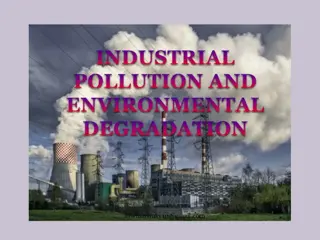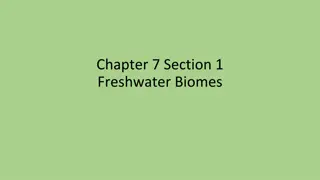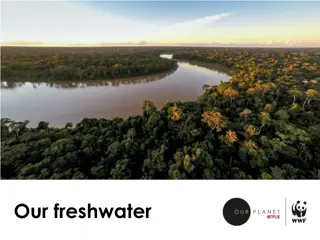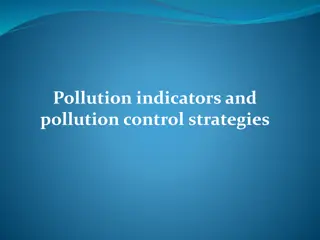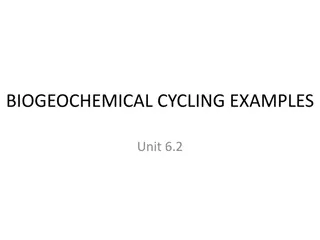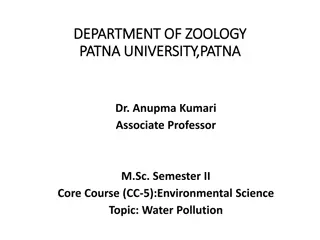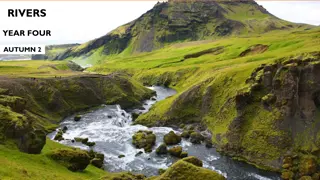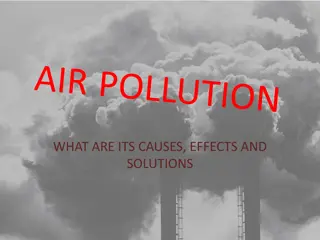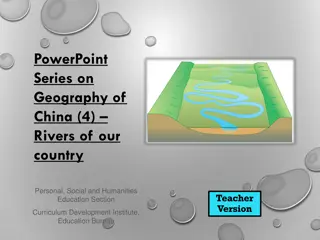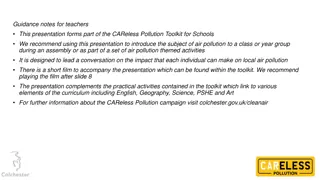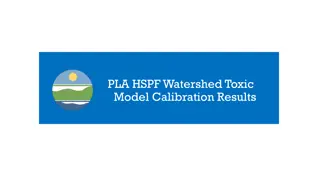Understanding Toxic Pollution in Rivers and Lakes
Toxic pollution in rivers and lakes is a pressing environmental issue caused by various pollutants such as metals, pesticides, chemicals, and microbial contaminants. These pollutants can have detrimental effects on aquatic life, human water use, and health. Learn about the impact of toxic pollutants and the importance of regulations to mitigate their harmful effects.
Download Presentation

Please find below an Image/Link to download the presentation.
The content on the website is provided AS IS for your information and personal use only. It may not be sold, licensed, or shared on other websites without obtaining consent from the author. Download presentation by click this link. If you encounter any issues during the download, it is possible that the publisher has removed the file from their server.
E N D
Presentation Transcript
Water Quality and Pollution Lesson 4. Toxic pollution in rivers and lakes
Toxic pollutants come in many forms: Metals from mining and industry (mercury, cadmium, lead) Pesticides from agriculture Chemicals from industrial processes Chemicals leaking from landfill sites Accidental spillages Microbial contamination All of these can have a big impact, not only on aquatic life but on human use of water and human health. 2
Environmental pioneer One of the most influential books ever written - Rachel Carson s Silent Spring led to the birth of the environmental movement in the 1960s. It is about the indiscriminate use of pesticides and their impact on the environment. Logo Description automatically generated with medium confidence https://www.pbslearningmedia.org/resource/envh10.s ci.life.eco.silentspring/rachel-carsons-silent-spring/ 4:48min 3
Toxic Pollution Toxic Pollutants damage or poison some vital system in the animal s body; for example, cyanide, which prevents cell respiration resulting in paralysis and death. Many toxic pollutants, such as pesticides, affect the nervous system. The environmental impact of some are well known, DDT was highlighted by Rachel Carson in her book Silent Spring which led to the birth of the environmental movement in the 1960s. Others may damage immune systems, reproductive systems or cause cancer. As impacts are not clear, following the precautionary principle, their use is highly regulated to avoid environmental and/or human health damage. Yet, the EPA report herbicides have been detected in two-thirds of all rivers surveyed in Ireland 4
Toxic Pollution Extreme care is needed when dealing with pesticides, as this report shows. Even small amounts used in gardens needed to be used and disposed of properly. 5
Microbial Pollution Water in rivers and lakes contain multitudes of bacteria and other micro-organisms that are beneficial for the functioning of aquatic ecosystems. http://www.healingtalks.com/wp-content/uploads/2014/08/Contamination-of-drinking-water.jpg However, water can carry harmful micro-organisms that don t occur naturally in the water but get there from contamination. This is why we treat drinking water to reduce the risk of disease. Most of the harmful micro-organisms are found naturally in gut of domestic and wild animals, and humans. They get into water when it s contaminated by faeces and urine. 6
Microbial Pollution continued E. coli bacterium occurring naturally in gut of humans and other animals. Can be beneficial, but some strains are disease-causing. The VTEC strain can cause kidney failure. Leptospira found in wild rodents. Causes Weil s Disease or Leptospirosis in humans. Cryptosporidium Parasite that lives in gut of livestock. Causes diarrhoea and fever in humans. Ireland has highest incidence of illness in EU; higher stocking rates of livestock - more animal waste is getting into rivers and lakes that supply drinking water. Very serious public water issue in Galway 2007. Is resistant to chlorination, so treatment involves more expensive methods. 7
Microbial contamination of water can result from: Cattle having access to a river or lake that supplies drinking water Slurry washing in after heavy rain Septic tanks located too near a stream, river or lake. Most people in Ireland get their water from rivers or lakes or reservoirs that are fed by surface water, so it s important to keep them free of contamination. Groundwater is another important source of water and that can get contaminated also. 8
Groundwater and Wells Groundwater originates as rainfall that percolates through the soil to the underlying subsoil and bedrock. Water Table In places (aquifers), the groundwater can be tapped by a well, for human use Saturated zone Groundwater flows through subsoil and cracks in bedrock, but very slowly (<0.5m per day). 9
Pollution source: Unsealed & illegal landfill Faulty septic tank Leaking slurry pit Leaking fuel storage tank, etc. Groundwater and Wells Can Be Contaminated Contaminated well. Almost of private wells are contaminated with E. coli. Water Table Pollution plume carried by groundwater flow can enter surface waterbodies, e.g. lakes and rivers. Groundwater 10
Parts of Ireland where the soil cover is thin, especially over limestone bedrock, are more at risk of well contamination. EPA publish advice on how to avoid well contamination and reduce health risks: https://www.epa.ie/environment -and-you/drinking- water/household-wells/ 11
Acidification An upland river in Co. Wicklow. Its water is naturally acidic but is made more so by the conifer plantations that are planted right up to the water s edge. It is too acid now for mayflies and young salmon to survive. Buffer zones of natural vegetation, including native woodland, along river margins would help restore a better pH. 12
Suspended Solids Silt, sand and clay particles A natural part of the river environment especially during floods A flood is the river equivalent of a hurricane - it does a lot of damage. Particles clog fish gills and smother spawning beds The impact is worse if the river banks have lost their natural vegetation and there are no plants or roots to strengthen the river bank - more suspended solids are eroded into the water. 13
Suspended Solids In heavy rain, a lot of sediment will be washed into the river from this cattle drinking spot 14
There are many sources of pressure on rivers and lakes Main pressures are agriculture (63%), hydromorphology, forestry and urban wastewater. Urban wastewater is improving Agriculture pressure is increasing A river or lake can have multiple pressures This image shows the pressures on our rivers and lakes (Source: EPA 2021). This means that the aim of good ecological status for rivers and lakes by 2027 is very unlikely to be achieved! 15 Task 4.1
Agriculture and Water Quality Pressure from agriculture is a difficult problem to solve because: N and P fertilizers are used extensively to support crop production. Pollution sources are diffuse and difficult to identify (there may be hundreds along a river). Solutions being implemented: Reducing nutrient application in sensitive catchments. Better nutrient management on farms. Intercepting nutrient run-off before it gets to rivers, lakes or groundwater (buffer strips). Placing silt traps close to water bodies. Calendars and technological fixes for slurry spreading. More radical solutions are proposed by environmental groups but getting local buy-in is not guaranteed. 16
Technical Innovations and Changing Practices are Important http://4.bp.blogspot.com/-fkhjGbMugro/Tib4LpAJFSI/AAAAAAAADGE/ij3z6nItp_8/s1600/Hay+Caps+%25232.jpg Switch from traditional hay to silage harvesting in early 1980s brought greater efficiency and productivity to agriculture http://www.independent.ie/migration_catalog/Non-Staff/article25046580.ece/ALTERNATES/h342/silage http://ww1.prweb.com/prfiles/2013/03/13/10727590/Bock%201.jpg 17
https://encrypted-tbn1.gstatic.com/images?q=tbn:ANd9GcTp1eT5Cmjus7aNaLU2FBmrxvq0QPVkpXFKcWQ5sfwcUMKR0f9nCwhttps://encrypted-tbn1.gstatic.com/images?q=tbn:ANd9GcTp1eT5Cmjus7aNaLU2FBmrxvq0QPVkpXFKcWQ5sfwcUMKR0f9nCw Effluent pollution Silage effluent leaking from a pit https://upload.wikimedia.org/wikipedia/commons/0/09/Smiling_silage_bales,_Swales_Moor_Road.jpg Pollution by silage effluent was a serious problem in the early days, but the introduction of bale- silage has now eliminated that. This was a win-win for farming and the environment. 18
What we need to do to restore water quality and good ecological status in rivers lakes and estuaries? 5 ideas 1. 2. 3. 4. 5. Task 4.2 19
Summary Toxic Pollutants includes metals, pesticides, herbicides, chemicals and microbial pollutants. Toxic pollutants damage or poison some vital system in the animal s body; for example, cyanide, which prevents cell respiration resulting in paralysis and death. Impacts also impair nervous systems, immune systems, reproduction and can cause cancers. Microbial Pollution is caused by bacteria, parasites and other micro-organisms that can contaminate aquatic ecosystems. Most of the harmful micro-organisms are found naturally in gut of domestic and wild animals, and humans. They get into water when it s contaminated by faeces and urine. Acidification when the pH level of water is increased owing to coniferous plantation along with waters edge, this has negative impacts on aquatic organisms. Suspended solids silt, sand and suspended particles washed off the land can clog fish gills and destroy micro-habitats needed for macro-invertebrate life and fish reproduction. Pollution challenges - how to produce food without negative environment impacts. 20




